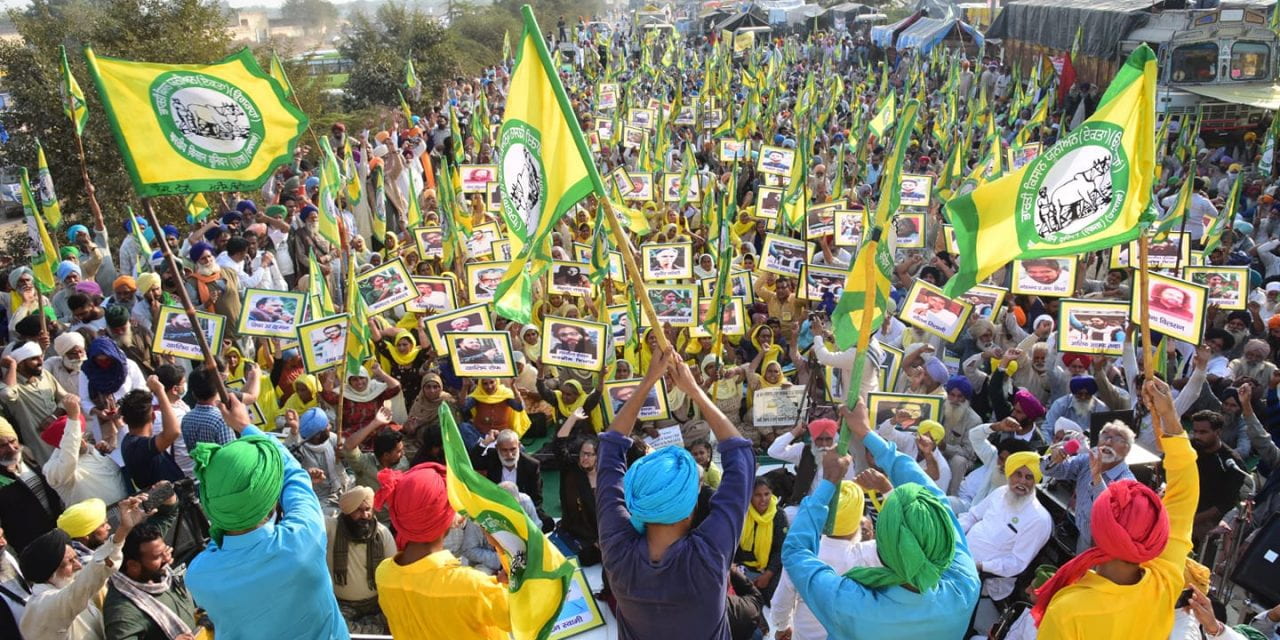Introduction
In August of 2020, the Parliament of India announced three new agricultural acts which sought to reform India’s farming industry. The so-called Farm Bills were made into law in the following September, prompting massive protests on behalf of farmers from several Indian states. The bills, in essence, deregulate certain aspects of the agricultural sector, such as minimum selling price and stockpiling limits, which were set up to protect the majority of India’s farmers who rely on such protections to compete with large corporations. They also create the foundations of an electronic trade network, which is an amenity that few farmers can afford, but one that serves the interests of national and global corporations. The farmers in several lesser-developed states saw the bills as an affront to their livelihood that the Indian government could use to attract foreign private investment. Since these initial demonstrations, the protests have grown exponentially, and farmers’ unions have put out a list of demands that would put an end to the tension.
Among these demands are calls not only for the removal of the Farm Bills, but also new legislation that they believe will help farmers deal with the hardships they faced before the Farm Bills were passed. After several months, the protests continued to escalate, garnering attention from the international community. The protests grew in size and intensity, leading to clashes with law enforcement. These clashes have resulted in hundreds of injuries and several fatalities. Because of the staggering number of people protesting, and the lengths that the Indian government has gone to in an attempt to shut down the protests, this topic warrants much attention. In order for India to move beyond this crisis in an equitable and sustainable fashion, the Indian government should revoke these bills and instead focus on remedying the hardships that India’s farmers, who make up a significant portion of their population, have been facing for so long.
For many farmers in India, the Farm Bills act as a stab in the back after decades of increasing hardships. In the past, the Prime Minister of India, Narendra Modi, had promised to bring change to the agricultural sector, and he claimed that the Farm Bills would actually work for the benefit of farmers. Despite this, many farmers, specifically those from regions such as Punjab, who have historically seen decreases in production and increasing costs, see the Farm Bills as a way to squeeze out the average farmer and give corporations free rein over India’s agricultural sector. Protest leaders noted that the Farm Bills have come when farmers are already in extremely difficult circumstances, citing an increasing number of suicides committed by farmers over the past several decades. [1] It can be safely said that many of India’s farmers have been in need of more government assistance for many years and that their concerns over the Farm Bills are a sign that they are in a very desperate situation. With a full understanding of the movement and its origins, it is apparent that for the sake of India’s farmers, the government should walk back on these harmful laws and should make a strong effort to ensure the rights of farmers, ensure a system of fair trade, and focus on modernizing rural regions for the sake of easing their hardships instead of eroding their way of life.
The Three Farm Bills
When the Farm Bills were passed in September 2020, the Indian government claimed they would renew the agricultural sector and allow corporations to more easily participate in the market. Prime Minister Modi said that the news laws would help bring technological innovation to India’s farmers that would increase production, calling the laws “a welcome step.” [2] In order to understand the justification for passing the laws, as well as what exactly prompted such a hostile response from farmers, a closer look at the three laws is necessary.
The first bill focuses mainly on the commerce aspect of the farming industry, amending the rules and regulations of how farmers are to trade and sell their produce, as well as proposing a new system of electronic based trade. The second bill creates a price assurance system and expands on contract farming. [3] The third bill, which came as a particular shock to farmers, removes limits on stockholding several different categories of produce, giving large-scale agricultural corporations an edge when it comes to supply and shipping. [4] Each of these bills sparked fear in regular farmers, specifically because the rights they guarantee only serve the purpose of aiding larger producers and offer rights that local farmers would not have much of a need for. Additionally, they create a framework in which corporations will have almost absolute control over pricing and supply, effectively squeezing farmers out of the market. Last but not least, the laws do away with the government-guaranteed minimum pricing for selling crops, a provision that helped farmers keep their heads above water in hard times. [5] With the abolition of this provision, corporations will be able to sell their products for much lower prices that farmers will be unable to compete with, according to protestors. [6] The main takeaway from these laws is that they would essentially give corporations the means to take control of India’s agricultural sector by eliminating the role of local producers and their ability to compete with these large firms. With all of these alarming policies becoming law, it was only a matter of time before protesters spoke out about their grievances and demanded a fair deal.
The Birth of the Movement
It did not take long for farmers to take to the streets, with the earliest demonstrations occurring before the bills even passed. Following the passage of the bills in September 2020, unions rallied farmers from several states, such as Punjab and Haryana. [7] The protests started out by being contained in individual states, with more local and contained demonstrations taking place. In many states, the main form of protest was blocking travel, such as shutting down Punjab’s rail system. [8] Not long after this, however, protesters from all over the country started to converge around Delhi. Protesters began blocking off several of the main highways leading into the city, and with the capitol surrounded, the Indian government decided to crack down on the protesters. [9] With a minimum estimate of 150,000 protestors attempting to block off Delhi, police were ordered to use force. [10] Blockades were erected, tear gas and water cannons were deployed, and fatalities started to be counted. [11] With this show of force from authorities, unions from across the country called for a general strike, resulting in an estimated 250 million workers striking on November 26th. [12] This drastic move raised the stakes significantly, and soon after the government agreed to talks for ending the protests. Any hopes of an end to the demonstrations would be futile at this point, however, as the government’s terms to meet, which included an immediate end to transportation blockages, were not accepted by farm unions. This stage of the protests continued for months, with highways being blocked, sporadic strikes occurring across the country, and the government using increasingly violent methods to try to send the protestors away.
The Movement Grows
January 26th is India’s Republic Day, celebrating India’s independence from Britain and the creation of a parliamentary republic. On January 26th, 2021 the protesters decided to hold a massive tractor rally, parading through the streets of Delhi. During this portion of the day’s demonstration, one farmer died while driving his tractor into a police barricade. The police claim that his tractor overturned and crushed his head, but many present at the parade, as well as the man’s family and the farm unions say that he had been shot in the head by police, showing evidence that they believe proves this. [13] Later in the day, protesters marched to the Red Fort, a historical landmark, fighting their way into the fort. This brawl led to hundreds of injuries on both sides. This heightening of tensions shook the nation, and the government followed by blocking the main protest sites and arresting farmers and journalists alike. [14]
Following this event, the protests gained much more attention internationally than they had previously. The government’s harsh response towards the demonstrators led other nations and international organizations to issue statements condemning the government’s actions and calling for the Indian government to enter into discussions with the demonstrators to bring the protests to an end. Condemnations of the government’s policy by figures such as Indian journalists and Western celebrities led to effigy burning on behalf of pro-government counter-protesters. [15] Related developments include the arrest of Disha Ravi, a 21-year-old climate activist, who was arrested on charges of sedition after publishing an online toolkit designed to assist the farmers in their demonstrations. Her arrest has become a focal point for the international community’s condemnation of the government’s response to the protests, and even more protests have broken out demanding that she be released. [16] In light of this increased attention, the protests’ organizers are putting much more of a focus on garnering international support. [17] At present, the situation remains unresolved, with neither side showing any sign of budging, and it is unlikely the protests will end any time soon.
Conclusion
In short, the Indian farmers’ protests have surged to become a nationwide movement that shows no sign of stopping until the farmers’ demands are met. With the harsh government response, it is also evident that Modi’s government has no plans to cede any ground to the protesters and fully intends for the laws to go into effect for the sake of revolutionizing the agricultural sector. Although the protests began in anger towards the farm bills, which would have an immense negative impact on the wellbeing of the average farmer, they have since become much more than protests against new legislation. They have come to be representative of decades of building anger by farmers towards a government that has failed to help them deal with growing hardship. The protests have also become a way for groups that have felt alienated or even persecuted by the Indian government, such as Sikhs and Muslims, to push back against Modi’s nationalist regime. The protests stem from a widespread distaste for the way India’s government has been treating disenfranchised groups, and it is for this reason that the protestors are so determined to remain on the streets until their demands are met.
With international pressure mounting for the government to enter into talks with organizers and reach an agreement, I believe it is time for the Indian government to not only repeal the laws, but also engage in further talks with these groups to find ways to address their preexisting grievances. By strengthening protections for farmers in the market, the Indian government will be ensuring that farmers can at the very least sustain themselves and their livelihoods. Then, by refocusing the modernization efforts away from corporations and towards development in rural regions by investing in infrastructure, electrification, and mechanization, the government will be alleviating farmers of many of their systemic hardships and increasing their productive capability. It seems overly hopeful to assume Modi would ever take this course of action because of his stubborn attitudes and his fervent support from many of India’s citizens, and thus I think that ultimately the international community should offer assistance to the farmers in any way possible. If a solution is not soon reached, it is likely that tensions could boil up even more than they did on Republic Day, which would be detrimental for stability in India.
[1] Yasmina Hatem, et al. “India Has a Farmer Suicide Epidemic – and Farmers Are Protesting New Laws They Fear Will Make Things Worse.” Business Insider, Business Insider, 7 Jan. 2021, www.businessinsider.com/india-farmers-protest-law-suicide-epidemic-2021-1.
[2] Shankhyaneel Sarkar. “PM Modi Calls Passage of Farm Bills ‘Watershed Moment’ for Agricultural Sector.” Hindustan Times, 20 Sept. 2020, www.hindustantimes.com/india-news/the-farm-bills-passed-in-parliament-will-not-only-bring-radical-changes-in-agriculture-sector-but-will-also-empower-farmers-tweets-pm-modi/story-Wsi1df81nxjXQFeAHXPVtI.html.
[3] PIB Delhi. Parliament Passes The Farmers’ Produce Trade and Commerce (Promotion and Facilitation) Bill, 2020 and The Farmers (Empowerment and Protection) Agreement of Price Assurance and Farm Services Bill, 2020, Press Information Bureau, 20 Sept. 2020, pib.gov.in/Pressreleaseshare.aspx?PRID=1656929.
[4] Times of India. “Farmers’ Protest Live Updates: It Is Our Duty to Ensure Farmers’ Produce Gets Good Markets and Good Roads Aid in That, Says PM Modi in Puducherry.” The Times of India, Times of India, 25 Feb. 2021, timesofindia.indiatimes.com/india/farmers-protest-live-updates-feb-25/liveblog/81201471.cms.
[5] Jessie Yeung. “Farmers across India Have Been Protesting for Months. Here’s Why.” CNN, Cable News Network, 15 Feb. 2021, www.cnn.com/2021/02/10/asia/india-farmers-protest-explainer-intl-hnk-scli/index.html.
[6] Ibid.
[7] Himanshu Shekhar Mishra, and Chandrashekar Srinivasan. “Massive Farmer Protests In Punjab, Haryana, Parts Of UP Over 3 Bills.” NDTV.com, NDTV, 25 Sept. 2020, www.ndtv.com/india-news/massive-farmers-protest-in-punjab-haryana-parts-of-uttar-pradesh-roads-rail-tracks-blocked-2300821.
[8] Avishek G. Dastidar “Explained: The Railways Network in Punjab, and How It Has Been Impacted by the Ongoing Protests.” The Indian Express, 11 Nov. 2020, indianexpress.com/article/explained/the-railways-network-in-punjab-and-how-it-has-been-impacted-by-the-ongoing-protests-7046586/.
[9] PTI. “Dilli Chalo: Farmers’ Protest Enters Fifth Day.” The Hindu, The Hindu, 30 Nov. 2020, www.thehindu.com/news/national/dilli-chalo-farmers-protest-enters-fifth-day/article33211234.ece.
[10] Chandigarh Ians. “Farmers Protest: Two Lakh More Set to Reach Delhi in 40km-Long Cavalcade.” Business Standard, Business-Standard, 28 Nov. 2020, www.business-standard.com/article/current-affairs/farmers-protest-two-lakh-more-set-to-reach-delhi-in-40km-long-cavalcade-120112800158_1.html.
[11] Tribune News Service. “Expired Tear Gas Shells Used in Haryana to Disperse Punjab Farmers.” Tribune India News Service, 28 Nov. 2020, www.tribuneindia.com/news/haryana/expired-tear-gas-shells-used-177431.
[12] Shemin Joy. “At Least 25 Crore Workers Participated in General Strike; Some States Saw Complete Shutdown: Trade Unions.” Deccan Herald, DH News Service, 26 Nov. 2020, www.deccanherald.com/national/at-least-25-crore-workers-participated-in-general-strike-some-states-saw-complete-shutdown-trade-unions-920200.html.
[13] Ismat Ara. “’Autopsy Doctor Told Me He’d Seen the Bullet Injury But Can Do Nothing as His Hands Are Tied’.” The Wire, 30 Jan. 2021, thewire.in/rights/autopsy-doctor-told-me-hed-seen-the-bullet-injury-but-can-do-nothing-as-his-hands-are-tied.
[14] Aishwarya Paliwal. “Farmer Leaders Betrayed Delhi Police, 394 Cops Injured, 19 Arrests Made: Commissioner.” India Today, 27 Jan. 2021, www.indiatoday.in/india/story/farmer-leaders-betrayed-delhi-police-394-cops-injured-19-arrests-made-commissioner-1763329-2021-01-27.
[15] Hannah Ellis-Petersen. “Greta Thunberg Effigies Burned in Delhi after Tweets on Farmers’ Protests.” The Guardian, Guardian News and Media, 4 Feb. 2021, www.theguardian.com/world/2021/feb/04/greta-thunberg-effigies-burned-in-delhi-after-tweets-on-farmers-protests.
[16] Sameer Yasir. “Indian Court Grants Bail to Activist Arrested Over Farmers’ Protests.” The New York Times, The New York Times, 23 Feb. 2021, www.nytimes.com/2021/02/23/world/asia/india-bail-disha-ravi.html.
[17] Times of India. “Farmers’ Protest Live Updates: It Is Our Duty to Ensure Farmers’ Produce Gets Good Markets and Good Roads Aid in That, Says PM Modi in Puducherry.” The Times of India, Times of India, 25 Feb. 2021, timesofindia.indiatimes.com/india/farmers-protest-live-updates-feb-25/liveblog/81201471.cms.







